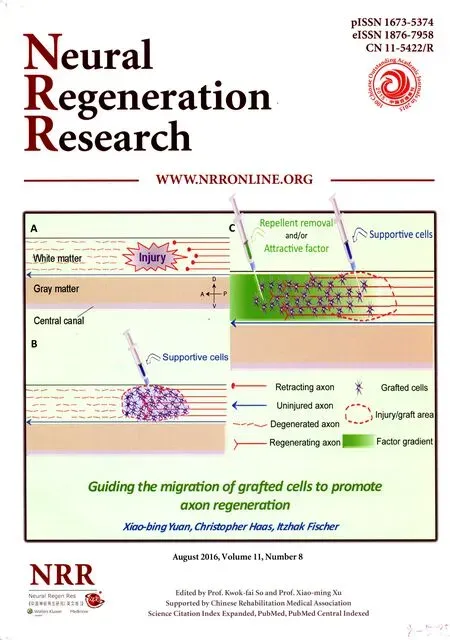中国神经再生研究(英文版)
- Uncoupling protein 2 in the glial response to stress: implications for neuroprotection
- Selective neuronal PTEN deletion: can we take the brakes off of growth without losing control?
- TRPV1 may increase the effectiveness of estrogen therapy on neuroprotection and neuroregeneration
- Tamoxifen: an FDA approved drug with neuroprotective effects for spinal cord injury recovery
- Automatic counting of microglial cell activation and its applications
- Prospects for bone marrow cell therapy in amyotrophic lateral sclerosis: how far are we from a clinical treatment?
- Volume transmission and receptor-receptor interactions in heteroreceptor complexes: understanding the role of new concepts for brain communication
- Guiding the migration of grafted cells to promote axon regeneration
- Potassium channel blockers restore axonal conduction in CNS trauma and diseases
- Ghrelin is the metabolic link connecting calorie restriction to neuroprotection
- Cell-specific mineralocorticoid receptors: future therapeutic targets for stroke?
- Skeletal muscle conditioning may be an effective rehabilitation intervention preceding functional electrical stimulation cycling
- Lithium: from mood stabilizer to putative cognitive enhancer
- Treating spinal cord injury via sustained drug delivery from calcium phosphate coatings
- Beyond reproduction: the role of progesterone in neuropathic pain after spinal cord injury
- Differing roles for parvalbumin neurons after nerve injury
- Melanopsin expression is an indicator of the well-being of melanopsinexpressing retinal ganglion cells but not of their viability
- Calcium channel inhibition-mediated axonal stabilization improves axonal regeneration after optic nerve crush
- A possible therapeutic potential of quercetin through inhibition of µ-calpain in hypoxia induced neuronal injury: a molecular dynamics simulation study
- Glucose metabolism and neurogenesis in the gerbil hippocampus after transient forebrain ischemia
- Endoplasmic reticulum stress-induced apoptosis in the penumbra aggravates secondary damage in rats with traumatic brain injury
- Safety of different acupuncture manipulations for posterior circulation ischemia with vertigo
- Difference in cortical activation during use of volar and dorsal hand splints: a functional magnetic resonance imaging study
- Dynamic expression of nerve growth factor and its receptor TrkA after subarachnoid hemorrhage in rat brain
- Protective mechanisms of microRNA-27a against oxygen-glucose deprivation-induced injuries in hippocampal neurons
- miRNA targeted signaling pathway in the early stage of denervated fast and slow muscle atrophy
- Curcumin upregulates S100 expression and improves regeneration of the sciatic nerve following its complete amputation in mice
- Antioxidative mechanism of Lycium barbarum polysaccharides promotes repair and regeneration following cavernous nerve injury
- Acellular allogeneic nerve grafting combined with bone marrow mesenchymal stem cell transplantation for the repair of long-segment sciatic nerve defects: biomechanics and validation of mathematical models
- Rebuilding motor function of the spinal cord based on functional electrical stimulation
- Association between chromosomal aberration of COX8C and tethered spinal cord syndrome: arraybased comparative genomic hybridization analysis
- No synergism between bis(propyl)-cognitin and rasagiline on protecting dopaminergic neurons in Parkinson's disease mice
- Huangqi Guizhi Wuwu Decoction for treating diabetic peripheral neuropathy: a meta-analysis of 16 randomized controlled trials
- Secondary parkinsonism induced by hydrocephalus after subarachnoid and intraventricular hemorrhage

